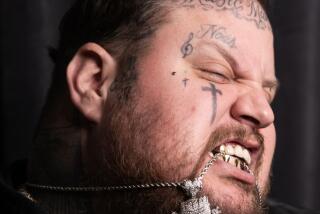Review: On ‚ÄėVulnicura,‚Äô Bjork is heavy and at her most personal
In the opening measures of Bj√∂rk‚Äôs new album, ‚ÄúVulnicura,‚ÄĚ the Icelandic artist offers a direct statement of purpose, one involving personal upheaval she describes as ‚Äúa juxtapositioning fate.‚ÄĚ Mentioning ‚Äúmoments of clarity as so rare, I better document this,‚ÄĚ Bj√∂rk directs her gaze in that first song, ‚ÄúStonemilker,‚ÄĚ on the dissolution of a relationship.
As she does so, what can be described only as Bj√∂rkian strings and beats swirl around her. These drifting arrangements soar through tracks like birds spinning circles in prairie skies, even as the experimental pop singer, 49, lyrically crawls through the brush below in utter confusion. At times devastated, others baffled, still others strong and determined, the artist on ‚ÄúVulnicura‚ÄĚ offers nine songs, six of which move in chronological order through that juxtapositional end and beyond.
The artist‚Äôs most personal record in a career full of vocal and emotional drama, ‚ÄúVulnicura‚ÄĚ is a self-described ‚Äúcomplete heartbreak album,‚ÄĚ its title Bj√∂rk‚Äôs own invented word. What it defines, though, is as lyrically raw and shockingly direct as Marvin Gaye‚Äôs ‚ÄúHere, My Dear‚ÄĚ or Beck‚Äôs ‚ÄúSea Change,‚ÄĚ and seems to document the end of her relationship with the visual artist Matthew Barney.
Referring to herself in a Facebook post as being ‚Äúkinda surprised how thoroughly I had documented this in pretty much accurate emotional chronology,‚ÄĚ the artist considered her creations to be ‚Äúlike 3 songs before a break up and three after.‚ÄĚ On early listens ‚ÄĒ the record arrived with little notice on Tuesday night ‚ÄĒ it‚Äôs an exquisite, inspired and typically angular listen, filled with much texture and impatient roaming, with musical and vocal tones built into spatial structures that fearlessly trace the lyrical ordeals.
Though Bj√∂rk, who has a daughter with Barney, never mentions her ex by name, she delivers lines about family ‚ÄĒ mothers, fathers and daughters in ‚ÄúFamily‚ÄĚ ‚ÄĒ that make it painfully apparent this is her take on a real-life situation. (Barney and Bj√∂rk reportedly ended their decade-long relationship in 2013.)
Bjork has seldom minced lyrics. Her previous album, ‚ÄúBiophilia,‚ÄĚ was thematically linked through lyrics about nature and the environment; her mostly a cappella 2004 album ‚ÄúMed√ļlla,‚ÄĚ recorded while she was pregnant, was overtly political. Rising in the 1990s after gaining popularity as the singer of Sugarcubes, her solo career has drawn on experimental electronic dance music and contemporary classical music, tracing and mixing styles and collaborating with musicians eager to work with such a voice.
Nuanced and miraculously expressive, her vocal cords growl and scowl, soar like clarinets and wail like violins. Hinting at voices as varied as Meredith Monk, Kate Bush, Maria Callas and the guy who sang ‚ÄúSurfin‚Äô Bird,‚ÄĚ it delivers singular vibrations.
She has thrived within musical partnerships, even as her work has traveled far afield of so-called popular music. Over the decades and seven earlier studio albums (excluding her self-titled 1977 debut, released when she was a young Icelandic pop star), she has teamed with innovative creators including Tricky, Matmos, Matthew Herbert, Mouse on Mars, Zeena Parkins and Mark Bell. For ‚ÄúBiophilia,‚ÄĚ Bj√∂rk worked solely with the British dubstep producers 16bit.
‚ÄúVulnicura‚ÄĚ sees her collaborating with a new pair: the English ambient producer who makes music as the Haxan Cloak and the Venezuelan producer Arca, whose tracks with Kanye West and FKA Twigs have driven his rise. As usual, Bj√∂rk arranges much of ‚ÄúVulnicura‚ÄĚ herself, with modernist string bursts, drifting, expansive patterns and punctuated squawks.
Those words are penned with a diary-esque honesty. ‚ÄúStonemilker,‚ÄĚ for example, is accompanied in the liner notes with the descriptive, ‚Äú9 months before.‚ÄĚ The next song ‚ÄúLionsong‚ÄĚ is described as occurring ‚Äú5 months before.‚ÄĚ The brief ‚ÄúHistory of Touches‚ÄĚ (‚Äú3 months before‚ÄĚ) hints at fading passion and a final bout of passion.
During the epic 10-minute centerpiece, ‚ÄúBlack Lake‚ÄĚ (‚Äú2 months after‚ÄĚ) after describing ‚Äúmy soul torn apart, my spirit is broken,‚ÄĚ Bj√∂rk goes for the jugular: ‚ÄúYou have nothing to give / Your heart is hollow / I‚Äôm drowned in sorrows / No hope in sight of ever recover / Eternal pain and horrors.‚ÄĚ
On ‚ÄúNotget,‚ÄĚ Bj√∂rk hits hard: ‚ÄúWithout love I feel the abyss / Understand your fear of death.‚ÄĚ
After those first six songs, the singer abandons time-stamping and moves through three closing pieces without markers. Suggesting that the end is evolving into a beginning, these works arrive like dawn after a thunderstruck night.
Collaborating with New York singer Antony, she sings of ‚Äúfine-tuning my soul‚ÄĚ in ‚ÄúAtom Dance,‚ÄĚ of letting ‚Äúthis ugly wound breathe‚ÄĚ and ‚Äúpeeling off dead layers of loveless love.‚ÄĚ
During a beat-heavy highlight, ‚ÄúMouth Mantra,‚ÄĚ the artist circles around and through Arca‚Äôs rhythms with sheets of sampled, manipulated voice, while lyrically addressing writer‚Äôs block.
‚ÄúVulnicura‚ÄĚ is a serious, heavy journey through a rough ordeal, a work certainly too deep to fully absorb so quickly after its release. Like many of her recent records, it‚Äôs not toe-tapping beat-based music. But fans like myself will find much to love as we explore its many peaks and valleys.
Whether the unnamed ex feels the same is another story.
Twitter: @LilEdit
------------------------------------
Björk
‚ÄúVulnicura‚ÄĚ
(One Little Indian)
3.5 out of 4 stars
More to Read
The biggest entertainment stories
Get our big stories about Hollywood, film, television, music, arts, culture and more right in your inbox as soon as they publish.
You may occasionally receive promotional content from the Los Angeles Times.











